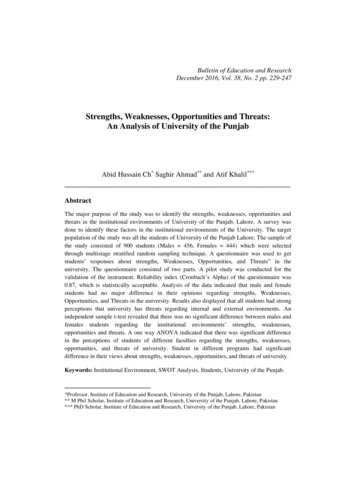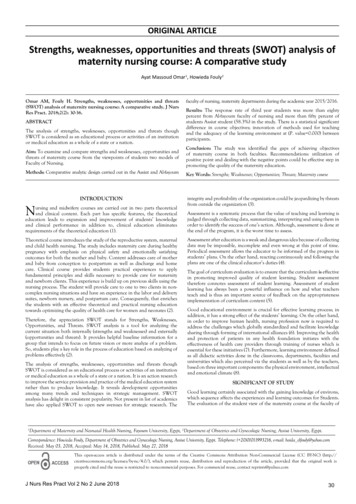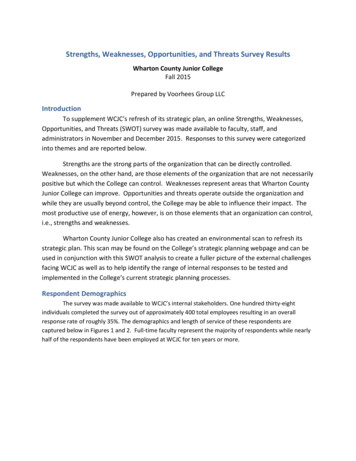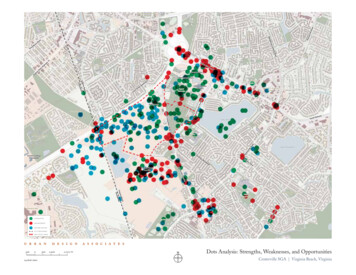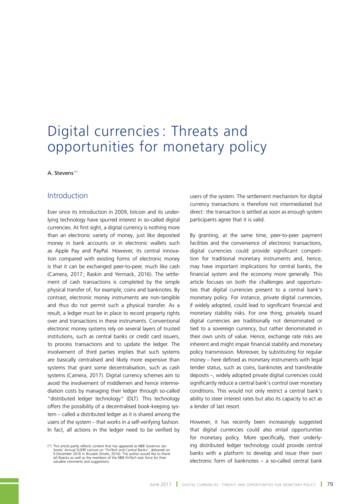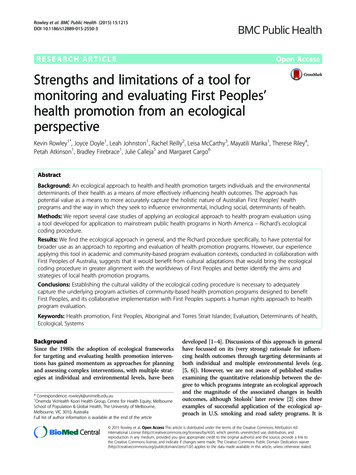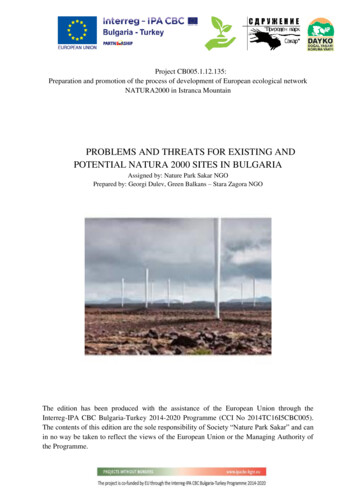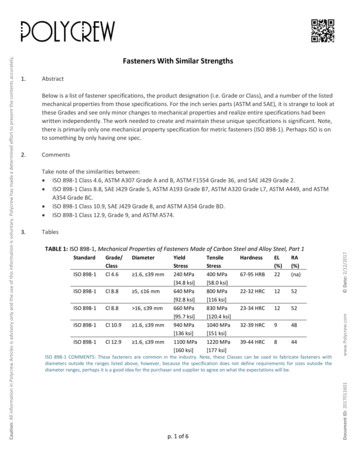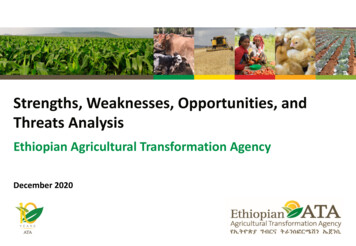
Transcription
Strengths, Weaknesses, Opportunities, andThreats AnalysisEthiopian Agricultural Transformation AgencyDecember 2020
ATA SWOT AnalysisWe have reviewed ATA’s organizational strengths, weaknesses,opportunities, and threats as the foundation of ATA’s 10-year strategy We are conducting a SWOT analysis for ATA as a standard foundation for ATA’s 10-YearStrategy Thorough review of ATA Org Navigator Survey 2020, an annual all staff survey where staff areinvited to comment anonymously on strategic and operational issuesReview of ATA Stakeholder Survey showing external partner views of ATAReview of ATA Financial and Institutional Audit reportsReview of multiple analytics studies including– ATA Studies Impact Evaluation Cases,– Implementation Status Assessment of ATA Studies Case,– ATA Resource Mobilization Case, and– ACC Governance CaseSMT interviewsRationale Approach 2
ATA SWOT AnalysisATA has demonstrated a number of particularly notable and uniquestrengths since inceptionTop Organizational StrengthsHighly adaptive learningorganizationAddresses systemic issues &intervenes at the SHF levelDemonstrated ability todeliver at scaleAbility to deliverinnovative projectsUnique analytical and datacapabilitySystem integration forstrategic programsStrategic thought-partnershipcapabilityStrong capability in resourcemobilizationHuman capital & leadershipcultureStrong IT systems &infrastructureStrong favourable imageamong its key partners–ATA responds to the changing needs of the sector e.g. adapting mandate areas to include project implementation tocater for limited implementation capacity in the sector–The ATA addresses systemic bottlenecks at the macro-level through the Agricultural Transformation Agenda, andoverlays this with geographical programs (e.g. the ACC) which focus on prioritized value chains in high-potential areasATA has rolled out large scale projects at a national scale (e.g. EthioSIS), and the ACC includes c.3.9m SHFsATA has a strong delivery culture, which is supported by its top-class systems, such as IMP and ERPFrom its scale delivery, ATA has influenced the working approach of agricultural organizations on the ground77% of ATA’s stakeholders state ATA is innovative, given its consistent delivery of innovative projects e.g. 8028ATA willingly risks failure in its drive for innovation, demonstrating failure is a key contribution to development–––––––––ATA established an Analytics & Data Unit which follows an international management consultancy model, breedingconsulting expertise which enables it to address changing priorities of the ATAATA has established institutions and platforms for coordination, including the Federal and Regional Delivery Units tocoordinate implementation partners, and a series of geographical platforms to address emerging issues within the ACCgeographic program (e.g. 84 VCAs and 6 RTCs held in 2011)ATA is sought after for thought-partnership by domestic and international development institutionsATA has collaborative partnerships with multiple renowned institutions e.g. CIMMYT on Wheat Rust, IFPRI, EABC––––––ATA has mobilized c. 300m since inception, leveraging a strong reputation across the agricultural sectorATA has received money from 30 diverse partner types with average donation from key donors increasing over timeThe ATA has curated an organization of diverse, talented staff of multiple capabilities as well as agronomistsEngaging, participative leadership culture: monthly SMT & Leadership mtgs, biweekly team mtgs,, annual all Org surveyThe Leadership Development Program nurtures ATA’s staff to improve their mgmt. and leadership capabilitiesA strong IT infrastructure underlies ATA’s operations, including the ERP and IMP systems, OneDrive for file storing andsharing, and an internal and external Communications platform–In the 2019 Stakeholder Survey, 78% of stakeholders stated the TADs had a positive contribution to the sector, with 62%of stakeholders saying the same of the ACC geographic program.SOURCE:ATA 10-Year Strategy, ATA Auditor’s Report, ATA Stakeholder Survey 2019, Resource Mobilization Case, ATA SMT Interviews3
ATA SWOT AnalysisWe are openly reflective about the organization’s weaknesses, and wehave purposefully tackled these weaknesses in ATA’s 10-Year StrategyKey Organizational WeaknessesUnable to retain high calibre staff––Existing Civil Service rules have hindered ATA’s ability to use an optimum pay structure to retain quality staffTwo of the three major weaknesses identified by Staff in the Org. Survey 2020 were pay and retention, with many staffleveraging ATA’s reputation to leap-frog to better paid jobs at international organizationsSuboptimal communicationstrategy and outputs––ATA has struggled to clarify its role as an Agency, being considered a threat to many actors in the ag. SectorInsufficient understanding about ATA’s mandates & achievements by key stakeholders at all levelsInsufficient engagement in criticalareas (e.g. Livestock)––ATA’s first geographic program – the ACC – prioritizes 10 commodities in Oromia, Amhara, SNNP, and TigrayInsufficient engagement in other critical areas e.g. Livestock, Emerging RegionsLimited coordination with otherstrategic programs–ATA currently lacks a clear methodology for this type of linkages & coordinationLimited capacity building forimplementation partners––Full engagement in capacity building would require the whole focus of the organizationATA must balance the sector requirement for capacity building with other mandate prioritiesInadequate focus on tracking––Inconsistent relationships withdifferent stakeholder types–––Inadequate focus on tracking during project design and implementationSome ATA projects do not have baseline surveys, and some projects do not have results frameworks; both issues renderit difficult (if not impossible) to assess the impact of these projectsATA has a very positive impact engaging the private sectorHowever, ATA’s relationship with NGOs is more variedInconsistent relationships with different stakeholders have affected implementation effectivenessLimited platform for knowledgemgmt & sharing–ATA’s official reports, strategies, and project documents are not in an easily accessible form, limiting externalstakeholders from fully understanding the contributions that ATA has made at all levelsMany distinct projects working insilo–ATA’s projects work predominantly in silo, with limited interaction between teams, meaning that synergies betweenprojects working underneath the same programs are lostSOURCE:ATA 10-Year Strategy, ATA Auditor’s Report, ATA Stakeholder Survey 2019, Resource Mobilization Case, ATA Studies Implementation Assessment Case, ATA SMT Interviews4
ATA SWOT AnalysisGoing forward, there are several strong opportunities which offer ATA aplatform for achieving greater impactTop Organizational OpportunitiesHighly supportive politicalenvironment and leadershipIncreased coordination withMoA and other institutions inthe sectorStrong national vision foragricultureAgriculture continues to bethe driver of economicdevelopmentGrowing internationalinvestment in AgriculturalIndustrial Parks––––Top leadership of the government is highly supportive and committed to transform the sectorThe MoA leadership are champions for ATA’s successes (e.g. ACC, Lowland Wheat)Regional governments are welcoming and coordinating closely with ATAGreater coordination and synergy with MoA & other institutions in the sector than every before, with ATAlinking its 10-Year Strategy to the MoA 10-Year Plan and is expected to have further alignment &coordination–The Home Grown Economic Reform Agenda outlines a clear, strong vision for Ethiopia and for agriculture,creating a more favourable environment for public and private sector and enhancing SHF access to servicesThe Minister’s 15 priorities outline a strong vision for agriculture over the next year––Ethiopia continues to promote agricultural-led industrialisation, putting agriculture at the forefront of itsgrowth strategy–Favourable interest by major international businesses to invest in Ethiopia’s agricultural sector through theAgro-Industrial Parks could enhance ATA’s ability to contribute to value-addition in the sectorExpansion of ruralinfrastructure–Infrastructure expansion from telecoms, to power, to roads, will likely increase the efficiency ofinterventions in the agriculture sector, and better facilitate ATA’s innovationIncreased national and donorfocus on Gender andNutrition––ATA has considerable expertise in gender and nutrition given its dedicated CCI teamATA’s experience in this field is demonstrated through application in its projects and strategic programs,through which it demonstrates best practise to its implementation partnersSOURCE:ATA 10-Year Strategy, ATA Auditor’s Report, ATA Stakeholder Survey 2019, Resource Mobilization Case, ATA SMT Interviews5
ATA SWOT AnalysisHowever, ATA also faces significant strategic and operational threats inthe years aheadKey Organizational ThreatsATA’s mandate is not wellunderstood by stakeholdersNo approval of strategy, policies& & procedures, and structureHigh expectations given limitedsupport & org size constraintsFrequent changes in strategicleadership (MoA, RBoAs)Frequent changes in (Woreda)operational leadershipInsufficient partner readinessfor transformationLimited institutional capacity innew expansion regions–There is continued confusion over the core elements of ATA’s mandate, especially versus the mandate of otheraffiliates of MoA, leading to tension between ATA and its stakeholders–As per the Institutional Audit, ATA’s current strategy, policies & procedures manuals, and organizational structurehave not been approved by the relevant government officials–Increasing demand for ATA from government organizations at both the Federal and the Regional level is at tensionwith common expectations that ATA should have a very small org size–Frequent turnover in institutional leadership of the sector at both Federal and Regional governments have been achallenge which made it difficult for ATA to follow or achieve its strategies, as it must cater to changing priorities–Frequent turnover in Woreda-level agricultural government makes it difficult for ATA to implement, as woredaleaders are more often than not learning the ropers–There is low partner readiness for transformation, limiting ATA’s ability to achieve its mandate–Risk that limited institutional capacity in new expansion regions may affect ATA’s ability to deliver its commitmentsResource Limitations–Risk that resource limitations within Ethiopia may negatively impact ATA’s ability to implementClimate change–Erratic rainfall, pest outbreaks (mainly locust outbreaks, and wheat rust ) may affect ATA’s ability to meet its targetsRecurring pests & diseases–ATA’s impact on increasing production and productivity may be effected by recurring pests and diseases (e.g. locusts)–ATA’s ability to implement effectively across the country may be limited by restrictions to movement as a result ofCOVID-19COVID-19SOURCE:ATA 10-Year Strategy, ATA Auditor’s Report, ATA Stakeholder Survey 2019, Resource Mobilization Case, ATA SMT Interviews6
Annex: Detailed Outcomes, Learnings, and Weaknesses & Challenges for theATA from the past 10 years7
Mandate AreasWe have analysed specific outcomes, learnings, and weaknesses &challenges for each of ATA’s 4 mandate areaMandate AreasIdentify systemic constraints of agriculturaldevelopment, through conducting studies,and recommend solutions in order to ensuresustainability and structural transformationRecommend and follow-up theimplementation of recommended solutionsas projectsProvide implementation support forrecommended solutions from studiesConduct linkages & coordination amongagricultural and related institutions andprojects in order to ensure the effectivenessof agricultural development activitiesStrategic ProgramsAgricultural Transformation AgendaSupport the identification andimplementation of interventions to addresssystemic bottlenecksGeographic programsCoordinate agricultural and related projectsin specific geographies tocatalyze agricultural transformationSource: Agricultural Transformation Council and Agency Establishment Council of Ministers Regulation No. 198 / 2010 and Agricultural Transformation Council and Agency Establishment Council of Ministers (Amended)Regulation No. 380 / 20168
Mandate Areas – StudiesATA has delivered more than 250 action-oriented strategic studies,primarily focused on systemic bottlenecks in agricultural systemsOutcomes Established highly effective Analytics Unit at ATA HQto conduct studies1.Policy & regulatory enhancementse.g. Barley Sourcing Policy Analysis, MinimumSupport Price Modeling & Monitoring2.Sector and value chain strategiese.g. Seed Sector Strategy, National AgriculturalExtension Strategy, Food & Beverage Strategy,Wheat Value Chain Strategy3.Business casese.g. EABC Strategic Review, Unilever InvestmentSupport4.5.Project design and scale upe.g. Case studies for Livestock and FisheriesDevelopment Project, Mechanization ServiceCenters Project DesignOrganizational enhancement studiese.g. Organization Rightsizing, LeadershipProgram DevelopmentSOURCE: ATA Studies Impact Analysis 250 studies completed to date, with majority of theseimplemented or utilized by stakeholders for decisionmaking:100%Includes studies which werepreviously put on hold or deprioritizedsuch as Acid Soil Strategy, Feed ExportBan Policy Analysis and DroughtInsurance Policy22%Other33%Used for decision-makingOrganization enhancement (34%) andpolicy (23%) studies most often usedfor decision-making45%Have been (or are being) implementedHighest implementation rates forProject design and scale-up (72%)2012-2020 G.C.9
Mandate Areas – Studies3 key learnings can be drawn from ATA’s vast experience conductingstrategic studies on Ethiopia’s agricultural sectorLearnings1.ATA’s management consultancy approach to studies allows ra
ATA SWOT Analysis ATA has demonstrated a number of particularly notable and unique strengths since inception Top Organizational Strengths – ATA responds to the changing needs of the sector e.g. adapting mandate areas to include project implementation to cater for limited implementation capacity in the sector Highly adaptive learning organization
